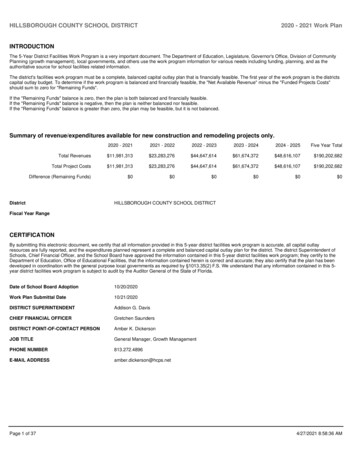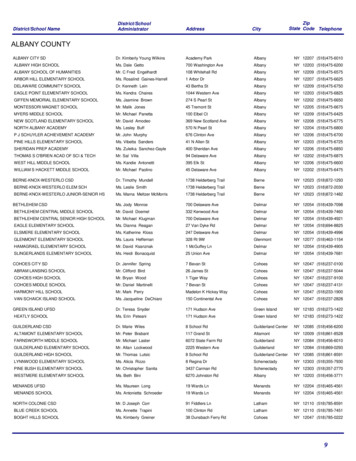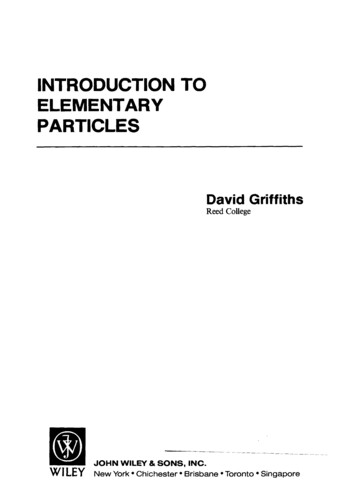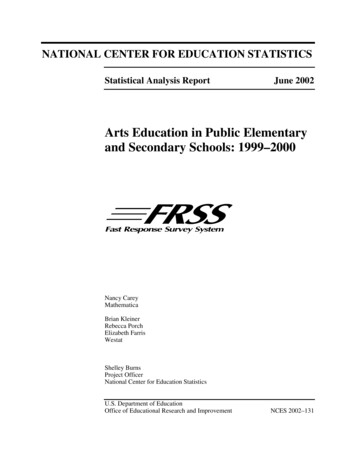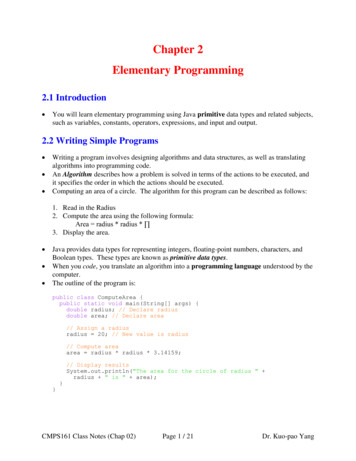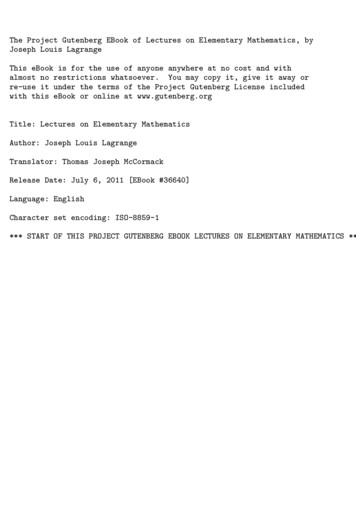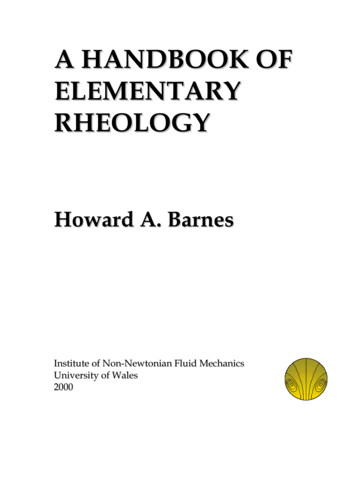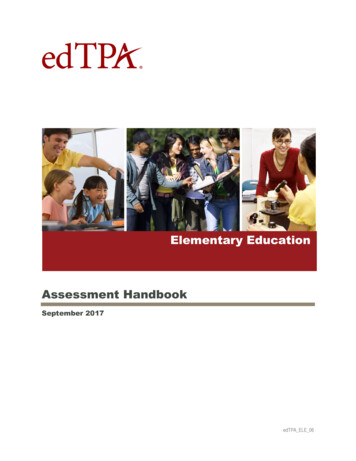
Transcription
Elementary EducationAssessment HandbookSeptember 2017edTPA ELE 06
edTPA stems from a twenty-five-year history of developing performance-based assessments ofteaching quality and effectiveness. The Teacher Performance Assessment Consortium (Stanfordand AACTE) acknowledges the National Board for Professional Teaching Standards, theInterstate Teacher Assessment and Support Consortium, and the Performance Assessment forCalifornia Teachers for their pioneering work using discipline-specific portfolio assessments toevaluate teaching quality. This version of the handbook has been developed with thoughtful inputfrom over six hundred teachers and teacher educators representing various national designteams, national subject matter organizations (ACEI, ACTFL, AMLE, CEC, IRA, NAEYC, NAGC,NCSS, NCTE, NCTM, NSTA, SHAPE America), and content validation reviewers. Allcontributions are recognized and appreciated.This document was authored by the Stanford Center for Assessment, Learning, and Equity (SCALE)with editorial and design assistance from Evaluation Systems.Copyright 2017 Board of Trustees of the Leland Stanford Junior University. All rights reserved.The edTPA trademarks are owned by The Board of Trustees of the Leland Stanford Junior University.Use of the edTPA trademarks is permitted only pursuant to the terms of a written license agreement.
edTPA Elementary Education Assessment HandbookContentsPreface . 1Introduction to edTPA Elementary Education. 2Purpose . 2Overview of the Assessment. 2Structure of the Handbook . 5edTPA Elementary Education Tasks Overview. 7Literacy Planning Task 1: Planning for Literacy Instruction and Assessment . 12What Do I Need to Think About? . 12What Do I Need to Do? . 12What Do I Need to Write? . 15How Will the Evidence of My Teaching Practice Be Assessed? . 17Literacy Planning Rubrics . 18Literacy Instruction Task 2: Instructing and Engaging Students in Literacy Learning . 23What Do I Need to Think About? . 23What Do I Need to Do? . 23What Do I Need to Write? . 25How Will the Evidence of My Teaching Practice Be Assessed? . 26Literacy Instruction Rubrics . 27Literacy Assessment Task 3: Assessing Students’ Literacy Learning . 32What Do I Need to Think About? . 32What Do I Need to Do? . 32What Do I Need to Write? . 33How Will the Evidence of My Teaching Practice Be Assessed? . 36Literacy Assessment Rubrics . 37Mathematics Assessment Task 4: Assessing Students’ Mathematics Learning . 43What Do I Need to Think About? . 43What Do I Need to Do? . 43What Do I Need to Write? . 45How Will the Evidence of My Teaching Practice Be Assessed? . 47Mathematics Assessment Rubrics . 48Professional Responsibilities . 51Elementary Literacy Context for Learning Information . 52Elementary Mathematics Context for Learning Information . 55Elementary Mathematics Learning Segment Overview . 58Elementary Education Evidence Chart . 59Literacy Planning Task 1: Artifacts and Commentary Specifications . 59Literacy Instruction Task 2: Artifacts and Commentary Specifications . 60Literacy Assessment Task 3: Artifacts and Commentary Specifications . 61Mathematics Assessment Task 4: Artifacts and Commentary Specifications . 64Elementary Education Glossary . 68Copyright 2017 Board of Trustees of the Leland Stanford Junior University.All rights reserved.i
5IJT EPDVNFOU DPOUBJOT CPUI JOGPSNBUJPO BOE EFGJOJUJPO QPQ VQT 5P SFBE JOGPSNBUJPO VTF UIF %PXO "SSPX GSPN B GPSN GJFME edTPA Elementary Education Assessment HandbookPrefaceThe edTPA Elementary Education assessment provides opportunities for teachingcandidates to demonstrate their ability to teach both literacy and mathematics in theelementary grades.This handbook includes all materials, directions, prompts, and rubrics for the four taskswithin the edTPA Elementary Education assessment—Tasks 1–3 are Elementary LiteracyTasks and Task 4 is an Elementary Mathematics Assessment Task.All four tasks are requirements for licensure in your state. As you prepare your evidence forthese tasks, you will document and demonstrate your teaching and your analysis of studentlearning.Faculty in your preparation program will advise you on when Tasks 1–3 and Task 4 need tobe completed to meet program requirements. All tasks must be completed within a formalstudent teaching experience wherein you have regular opportunities to teach lessons andcarry out assessments with students. Tasks 1–3 or Task 4 may be completed in either order;however, you must submit all final materials in the same scoring/reporting window asdirected by your program.Tasks 1–3: Elementary Literacy Tasks—For the Elementary Literacy Tasks, you willdocument a cycle of teaching that includes planning 3–5 lessons, videorecording yourteaching, and analyzing your teaching and your students’ learning, with attention tostudents’ academic language development and use.Task 4: Elementary Mathematics Assessment Task—For the Elementary Mathematics Task,you will focus on analysis of your students’ learning in mathematics (drawn from a learningsegment of 3–5 lessons) and a re-engagement lesson that addresses your students’learning needs.If your program requires you to submit artifacts and commentaries for official scoring, referto www.edTPA.com for complete and current information before beginning your work and todownload templates for submitting materials. The website contains information about theregistration process, submission deadlines, submission requirements, withdrawal/refundpolicies, and score reporting. It also provides contact information should you have questionsabout your registration and participation in edTPA.Whether submitting directly to www.edTPA.com or via your program’s electronic portfoliomanagement system, follow the submission guidelines as documented in the EvidenceChart and review edTPA Submission Requirements to ensure that your materials conform tothe required evidence specifications and requirements for scoring.You will find additional support materials to complete these assessments at the website andfrom your preparation program advisors.Copyright 2017 Board of Trustees of the Leland Stanford Junior University.All rights reserved.1 of 75
edTPA Elementary Education Assessment HandbookIntroduction to edTPA ElementaryEducationPurposeThe purpose of edTPA Elementary Education, a nationally available performance-basedassessment, is to measure novice teachers’ readiness to teach both literacy andmathematics in the elementary grades. The assessment is designed with a focus on studentlearning and principles from research and theory. It is based on findings that successfulteachersdevelop knowledge of subject matter, content standards, and subject-specificpedagogydevelop and apply knowledge of varied students’ needsconsider research and theory about how students learnreflect on and analyze evidence of the effects of instruction on student learningAs a performance-based assessment, edTPA is designed to engage candidates indemonstrating their understanding of teaching and student learning in authentic ways.Overview of the AssessmentThe edTPA Elementary Education assessment is composed of four tasks:1. Planning for Literacy Instruction and Assessment2. Instructing and Engaging Students in Literacy Learning3. Assessing Students’ Literacy Learning4. Assessing Students’ Mathematic LearningThe edTPA Elementary Education assessment is designed for teacher education programsthat plan to implement the full edTPA in Elementary Literacy (Tasks 1–3), and also requirecandidates to demonstrate their readiness to teach by completing the ElementaryMathematics Assessment Task (Task 4).For the Elementary Literacy Assessment Tasks, you will first plan 3–5 consecutiveliteracy lessons referred to as a learning segment. Consistent with recommendationsprovided by the International Reading Association 1 (2010) for literacy professionals, alearning segment prepared for this assessment should reflect a balanced literacy curriculum.This means your learning segment should include learning tasks in which students haveopportunities to develop an essential literacy strategy for comprehending or composing textand the related skills that directly support that strategy.1 The Standards for Reading Professionals can be found at t 2017 Board of Trustees of the Leland Stanford Junior University.All rights reserved.2 of 75
edTPA Elementary Education Assessment HandbookYou will then teach the learning segment, making a videorecording of your interactions withstudents during instruction. You will also assess, informally and formally, students’ learningthroughout the learning segment. Upon completion of the three tasks, you will submitartifacts from the tasks (e.g., lesson plans, clips from your videorecording, assessmentmaterials, instructional materials, student work samples), as well as commentaries that youhave written to explain and reflect on the Planning, Instruction, and Assessmentcomponents of the tasks. The artifacts and commentaries for each task will then beevaluated using rubrics especially developed for each task.For the Elementary Mathematics Assessment Task, you will develop or adapt a relevantassessment of student learning, analyze student work, and design re-engagementinstruction to develop students’ mathematics understanding. Consistent with the Principlesand Standards for School Mathematics (2000), candidates’ responses to this task shouldreflect a balanced approach to mathematics, including opportunities for students to developconceptual understanding, procedural fluency, and mathematical reasoning/problem-solvingskills as well as to communicate precisely about their mathematical understanding. This taskcenters on two high-leverage teaching practices: using assessments to analyze studentlearning and re-engaging 2 students to develop their understanding of specific mathematicalconcepts.The edTPA Tasks and the Cycle of Effective TeachingThe edTPA tasks represent a cycle of effective teaching (i.e., teaching that is focused onstudent learning). The edTPA Elementary Literacy Tasks begin at the planning stage of thecycle, and the Elementary Mathematics Assessment Task begins at the assessment stageof the cycle to inform further planning. Literacy Planning Task 1 documents your intendedteaching, Literacy Instruction Task 2 documents your enacted teaching, and LiteracyAssessment Task 3 documents the impact of your teaching on student learning.2Re-engage means to support students to revisit and review a topic with a different set of strategies, representations, and/orfocus to develop understandings and/or correct misconceptions.Copyright 2017 Board of Trustees of the Leland Stanford Junior University.All rights reserved.3 of 75
edTPA Elementary Education Assessment HandbookThe four tasks and the evidence you provide for each are framed by your understandings ofyour students and their learning. As you develop, document, teach, and assess yourlessons, you will reflect upon the cyclical relationship among planning, instruction, andassessment, with a focus on your students’ learning needs.Evidence of Teaching Practice: Artifacts and CommentariesAn essential part of edTPA is the evidence you will submit of how you planned, taught, andassessed your lessons to deepen student learning in literacy and mathematics. Thisevidence includes both artifacts and commentaries:Artifacts represent authentic work completed by you and your students. Theseinclude lesson plans, copies of instructional and assessment materials, video clips ofyour teaching, and student work samples.Commentaries are your opportunity to describe your artifacts, explain the rationalebehind their choice, and analyze what you have learned about your teaching practiceand your students’ learning. Note that although your writing ability will not be scoreddirectly, commentaries must be clearly written and well focused.When preparing your artifacts and commentaries, refer to the rubrics frequently to guideyour thinking, planning, and writing. Refer to the Elementary Education Evidence Chart forinformation about how your evidence should be formatted for electronic submission.Copyright 2017 Board of Trustees of the Leland Stanford Junior University.All rights reserved.4 of 75
edTPA Elementary Education Assessment HandbookEvaluation CriteriaThe rubrics used to score your performance are included in this handbook, following thesections describing the directions for each task. The descriptors in the five-level rubricsaddress a wide range of performance, beginning with the knowledge and skills of a novicenot ready to teach (Level 1) and extending to the advanced practices of a highlyaccomplished beginner (Level 5).Structure of the HandbookThe following pages provide specific instructions on how to complete each of the four tasksof the edTPA Elementary Education assessment. After an overview of the tasks, thehandbook provides instructions for each task, organized into four sections:1. What Do I Need to Think About?This section provides focus questions for you to think about when completing thetask.2. What Do I Need to Do?This section provides specific, detailed directions for completing the task.3. What Do I Need to Write?This section tells you what you need to write and also provides specific and detaileddirections for writing the commentary for the task.4. How Will the Evidence of My Teaching Practice Be Assessed?This section includes the rubrics that will be used to assess the evidence you providefor the task.Additional requirements and resources are provided for you in this handbook:Professional Responsibilities: guidelines for the development of your evidenceElementary Literacy Context for Learning Information: prompts used to collectinformation about the school/classroom context for the Elementary Literacy learningsegmentElementary Mathematics Context for Learning Information: prompts used tocollect information about the school/classroom context for the ElementaryMathematics learning segmentElementary Mathematics Learning Segment Overview: a template fordocumenting the central focus, content standards, objectives, and assessmentsassociated with the Elementary Mathematics learning segmentElementary Education Evidence Chart: specifications for electronic submission ofevidence (artifacts and commentaries), including templates, supported file types,number of files, response length, and other important evidence specificationsGlossary: definitions of key terms can be accessed by rolling your cursor over eachglossary term marked with a dotted underline throughout the handbook or byreferring to the Elementary Education Glossary.You should review the Making Good Choices document prior to beginning the planning ofthe learning segment. If you are in a preparation program, it will have additional resourcesthat provide guidance as you develop your evidence.Copyright 2017 Board of Trustees of the Leland Stanford Junior University.All rights reserved.5 of 75
edTPA Elementary Education Assessment HandbookReview all instructions carefully before beginning to teach the learning segment toensure that you are well prepared for all tasks. Before you record your videos,pay particular attention to the specific content focus of each video clipsubmission; these foci are described in the What Do I Need to Do? sections inLiteracy Instruction Task 2 and Literacy Assessment Task 3. Refer to theProfessional Responsibilities section of this handbook for information aboutpermissions, confidentiality, and other requirements.If your program requires you to submit artifacts and commentaries for officialscoring, refer to www.edTPA.com for complete and current information beforebeginning your work and to download templates for submitting materials. Thewebsite contains information about the registration process, submission deadlines,submission requirements, withdrawal/refund policies, and score reporting. It alsoprovides contact information should you have questions about your registration andparticipation in edTPA.Whether submitting directly to www.edTPA.com or via your program’s electronicportfolio management system, follow the submission guidelines as documented inthe Evidence Chart and review edTPA Submission Requirements to ensure thatyour materials conform to the required evidence specifications and requirements forscoring.Copyright 2017 Board of Trustees of the Leland Stanford Junior University.All rights reserved.6 of 75
edTPA Elementary Education Assessment HandbookedTPA Elementary Education Tasks OverviewLiteracy Planning Task 1: Planning for Instruction and AssessmentWhat to Do Select one class as a focus for thisassessment. Provide relevant context information. Identify a learning segment to plan, teach,and analyze student learning. Yourlearning segment should include 3–5consecutive literacy lessons. Determine a central focus for yourlearning segment. The central focusshould support students to develop anessential literacy strategy forcomprehending or composing text andrelated skills that directly support thatstrategy. Write and submit a lesson plan for eachlesson in the learning segment. Select and submit key instructionalmaterials needed to understand what youand the students will be doing. Choose one language function and otherlanguage demands important tounderstanding elementary literacy in yourlearning segment. Identify a learning taskwhere students are supported to use thislanguage. Identify both the language function thatstudents will be expected to use toengage in the learning task and yourinstructional supports for that language. Respond to commentary prompts prior toteaching the learning segment. Submit copies of all written assessmentsand/or clear directions for any oral orperformance assessments from thelearning segment.What to SubmitPart A: Literacy Context forLearning InformationPart B: Lesson Plans forLearning SegmentPart C: Instructional MaterialsPart D: Literacy AssessmentsPart E: Literacy PlanningCommentaryCopyright 2017 Board of Trustees of the Leland Stanford Junior University.All rights reserved.Evaluation RubricsLiteracy Planning RubricsRubric 1: Planning for LiteracyLearningRubric 2: Planning to SupportVaried Student Learning NeedsRubric 3: Using Knowledge ofStudents to Inform Teachingand LearningRubric 4: Identifying andSupporting Language DemandsRubric 5: Planning Assessmentsto Monitor and Support StudentLearning7 of 75
edTPA Elementary Education Assessment HandbookLiteracy Instruction Task 2: Instructing and Engaging Students in LiteracyLearningWhat to Do Obtain required permissions forvideorecording from parents/guardians ofyour students and other adults appearingin the video. Identify lessons from the learning segmentyou planned in Literacy Planning Task 1 tobe videorecorded. You should chooselessons that show you interacting withstudents to support them to independentlyapply the essential literacy strategy andrelated skills to comprehend OR composetext in meaningful contexts. Videorecord your teaching and select 2video clips (no more than 20 minutestotal, but not less than 3 minutes). Analyze your teaching and your students’learning in the video clips by responding tocommentary prompts.What to SubmitPart A: Video ClipsPart B: Literacy InstructionCommentaryCopyright 2017 Board of Trustees of the Leland Stanford Junior University.All rights reserved.Evaluation RubricsLiteracy Instruction RubricsRubric 6: Learning EnvironmentRubric 7: Engaging Students inLearningRubric 8: Deepening StudentLearningRubric 9: Subject-SpecificPedagogy: Elementary LiteracyRubric 10: Analyzing TeachingEffectiveness8 of 75
edTPA Elementary Education Assessment HandbookLiteracy Assessment Task 3: Assessing Students’ Literacy LearningWhat to Do Select one assessment from the learningsegment that you will use to evaluate yourstudents’ developing knowledge and skills.Attach the assessment used to evaluatestudent performance to the end of theAssessment Commentary. Define and submit the evaluation criteriayou will use to analyze student learning. Collect and analyze student work from theselected assessment to identifyquantitative and qualitative patterns oflearning within and across learners in theclass. Select 3 student work samples toillustrate your analysis of patterns oflearning within and across learners in theclass. At least 1 of the samples must befrom a student with specific learningneeds. These 3 students will be yourfocus students. Summarize the learning of the wholeclass, referring to work samples from the 3focus students to illustrate patterns instudent understanding across the class. Submit feedback for the work samples forthe 3 focus students in written, audio, orvideo form. Analyze evidence of students’ languageuse from (1) the video clips from LiteracyInstruction Task 2, (2) an additional videoclip of one or more students usinglanguage within the learning segment,AND/OR (3) the student work samplesfrom Literacy Assessment Task 3. Analyze evidence of student learning andplan for next steps by responding tocommentary prompts.What to SubmitEvaluation RubricsPart A: Student Literacy Work Literacy Assessment RubricsSamplesRubric 11: Analysis of StudentPart B: Evidence of Feedback LearningPart C: Literacy AssessmentCommentaryRubric 12: Providing Feedbackto Guide Further LearningPart D: Evaluation CriteriaRubric 13: StudentUnderstanding and Use ofFeedbackCopyright 2017 Board of Trustees of the Leland Stanford Junior University.All rights reserved.Rubric 14: Analyzing Students’Language Use and LiteracyLearningRubric 15: Using Assessmentto Inform Instruction9 of 75
edTPA Elementary Education Assessment HandbookMathematics Assessment Task 4: Assessing Students’ Mathematics LearningWhat to DoWhat to Submit Select one class as a focus for thisassessment.Part A: Mathematics Contextfor Learning Information Provide relevant context information and alearning segment overview.Part B: ElementaryMathematics LearningSegment Overview Identify a learning segment of 3–5consecutive mathematics lessons. Identify a central focus. The central focusshould support students to developconceptual understanding, proceduralfluency, and mathematicalreasoning/problem-solving skills. Develop or adapt a formative assessmentfrom the learning segment that will allowyou to assess whole class learning. Theassessment should provide opportunitiesfor students to demonstrate conceptualunderstanding, computational/procedural fluency, and mathematicalreasoning/problem-solving skills.Part C: Mathematics ChosenFormative AssessmentPart D: Evaluation CriteriaEvaluation RubricsMathematics AssessmentRubricsRubric 16: Analyzing WholeClass UnderstandingsRubric 17: Analyzing IndividualStudent Work SamplesRubric 18: Using Evidence toReflect on TeachingPart E: Student MathematicsWork SamplesPart F: Examples of StudentWork from Re-engagementLessonPart G: MathematicsAssessment Commentary Submit a blank copy of the assessmentused to evaluate student performance. Define and submit the evaluation criteriayou will use to analyze student learning. Summarize the class performance on theformative assessment completed duringthe learning segment. Analyze 3 focus students’ work samples toidentify the targeted learningobjective/goal for the re-engagementlesson. Write a re-engagement lesson thatdevelops student understanding of thetargeted learning objective/goal. Implement the lesson with the 3 focusstudents individually, in a small group, orwith the whole class. Collect and submit the work samples fromthe re-engagement lesson for the 3 focusstudents. Evaluate the effectiveness of the reengagement lesson.Copyright 2017 Board of Trustees of the Leland Stanford Junior University.All rights reserved.10 of 75
edTPA Elementary Education Assessment HandbookTasks 1–3:Elementary LiteracyThe three Elementary Literacy Tasks begin on the next page of this handbook. For theElementary Literacy Tasks, you will document a cycle of teaching (for a learning segment of3–5 lessons) that includes planning, instruction, and assessment of student learning, andanalysis of your teaching, with attention to students’ academic language development anduse.The three Elementary Literacy Tasks can be completed before or after you complete theElementary Mathematics Assessment Task, but materials for ALL tasks must be submittedfor official scoring during the same scoring/submission window.Check with your preparation program advisor before completing or submitting your edTPAevidence.Copyright 2017 Board of Trustees of the Leland Stanford Junior University.All rights reserved.11 of 75
edTPA Elementary Education Assessment HandbookLiteracy Planning Task 1: Planning forLiteracy Instruction and AssessmentWhat Do I Need to Think About?In Literacy Planning Task 1, you will describe your plans for the learning segment andexplain how your instruction is appropriate for the students and the content you areteaching. As you develop your plans, you need to think about the following:What do your students know, what can they do, and what are they learning to do?What do you want your students to learn? What are the important understandingsand core concepts you want students to develop within the learning segment?How will you use your knowledge of your students’ assets to inform your plans?What instructional strategies, learning tasks, and assessments will you design tosupport student learning and language use?How will your learning segment support students to develop and use language thatdeepens content understanding?How is the teaching you propose supported by research and theory about howstudents learn?What Do I Need to Do?Select a class. If you teach more than one class, select one focus class for thisassessment. If your placement for elementary literacy has you responsible for a grouprather than a whole class, plans should describe instruction for that group (minimum of4 students). That group will constitute “the whole class” for edTPA Tasks 1–
This handbook includes all materials, directions, prompts, and rubrics for the four tasks within the edTPA Elementary Education assessment—Tasks 1–3 are Elementary Literacy Tasks and Task 4 is an Elementary Mathematics Assessment Task. All four tasks are requirements for
